
Böttcherstraße is a street in the historic centre of Bremen, Germany. Only about 100 m (330 ft) long, it is famous for its unusual architecture and ranks among the city's main cultural landmarks and visitor attractions. Most of its buildings were erected between 1922 and 1931, primarily as a result of the initiative of Ludwig Roselius, a Bremen-based coffee-trader, who charged Bernhard Hoetger with the artistic supervision over the project. The street and its buildings are a rare example of an architectural ensemble belonging to a variant of the expressionist style. Several of the houses can be classed as Brick Expressionism. Since 1973, the ensemble has been protected by the Monument Protection Act.
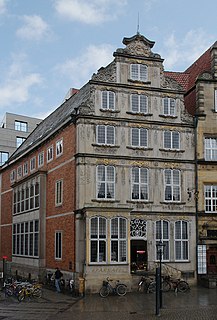
Haus der Stadtsparkasse is a Rococo landmark on the "Marktplatz" in Bremen, Germany. It was completed in the 1950s combining the historic front gable from another site with the more recent architecture of the remainder of the building.

The old Rathscafé, now named Deutsches Haus, is a listed building on the market place (Marktplatz) in Bremen, Germany. It is part of the monument ensemble No. 1–21.

The Bremer Marktplatz is a square situated in the centre of the Hanseatic City of Bremen, Germany. One of the oldest public squares in the city, it covers an area of 3,484 m2 (37,500 sq ft). It is no longer used as a market place except for the Christmas market and the annual Freimarkt Fair at the end of October.
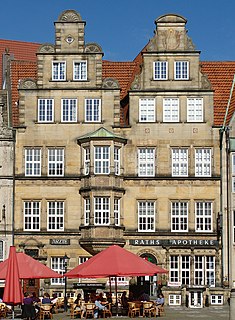
The Raths-Apotheke is a listed building on the Market Square (Marktplatz) in Bremen, Germany. After suffering war damage, the building was restored with two gables in the Neobaroque style in 1958, re-establishing the square's sequence of gabled buildings dating from the 1820s.
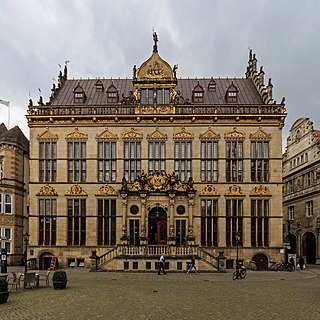
The Schütting, situated on the Marktplatz in Bremen, Germany, initially served the city's merchants and tradesmen as a guild house. In 1849, it became Bremen's chamber of commerce. Since 1973, it has been under monument protection. It lies on the south site of the Bremen marketplaces directly across from the town hall.
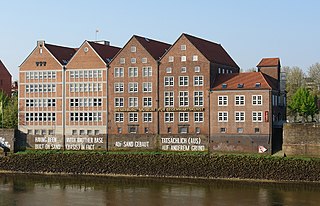
The Weserburg is a modern art museum in Bremen, Germany. Opened in 1991, it is located on the Teerhof peninsula next to the River Weser in an old factory building which was almost completely destroyed in the Second World War. Originally known as "New Museum Weserburg Bremen", it was Europe's first "collectors' museum", in that it conserves no permanent collection but mounts changing exhibition of private collections. It is one of the largest modern art museum spaces in Germany.
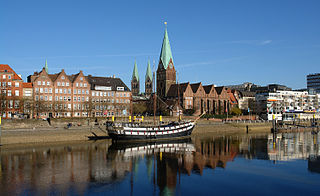
The Schlachte is a promenade along the east bank of the River Weser in the old town of Bremen in the north of Germany. Once one of the city's harbours, it is now popular for its restaurants, beer gardens and river boats.

Domsheide is a major square in the city of Bremen, Germany. It is located east of the Marktplatz and south of Bremen Cathedral. Streets leading to it include Ostertorstraße, Dechanatstraße, Balgebrückstraße and Violenstraße. It contains a number of important buildings, including the main post office, the courthouse, the cathedral precinct with the bell, and the annex to the stock market building. It is one of three main hubs of the public transport network, with most tram routes and two important bus lines crossing the square. The design of the Domsheide is relatively uneven, characterized by materials such as sandstone, dark red brick, red and yellow clinkers, render, concrete and marble.
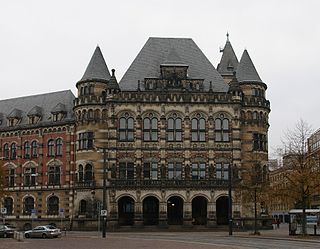
The Landgericht Bremen in the courthouse of the State of Bremen on the Domsheide in the old town of Bremen, Germany. It was built in the late 19th century in the French Renaissance style and completed in 1906. It has been a listed building since 1992. In addition to the judicial services of the regional court, the building houses sections of the Public Prosecutor's department (Staatsanwaltschaft) and of the district court (Amtsgericht).

The Kontorhaus am Markt in Bremen is a historical building in the city centre of Bremen, Germany. Today, it is used as a shopping mall. It is situated at the Bremer Marktplatz between three streets: Langenstrasse 2/8, Stintbruecke 1 and Bredenstrasse 13.

The Teerhof is a peninsula between the River Weser and the Kleine Weser, opposite the city centre of Bremen, Germany. It was first mentioned in 1624 as "Theerhof" when it was the northernmost part of an island. Today it consists mainly of residential buildings and the Weserburg modern art museum.

Viertel is a centrally located neighborhood in the city of Bremen, Germany. It lies east of the old town on the border between two different administrative subdistricts: Ostertor and Steintor. Today it is known for its numerous cafés, restaurants, and boutique shops.

The Langenstraße is a historical street in the old town of Bremen in the north of Germany. First mentioned in 1234, it is one of Bremen's oldest streets and one of the most important for the city's merchants. It no doubt originated at the time when the first settlements grew up on the north bank of the Balge. It runs west from the Marktplatz parallel to the River Weser over Bürgermeister-Smidt-Straße to Geeren. Many of the street's historic buildings were seriously damaged during aerial bombings in the Second World War but were carefully reconstructed in the postwar period.

The Suding & Soeken building is a gabled house at No. 28 Langenstraße in Bremen, Germany. Referred to as a Kaufmannshaus or Kontorhaus, it is one of the city's few historic merchant houses to survive the war undamaged. It is noted for its projecting Renaissance bay window and its two-tiered Baroque stairway ascending from the hallway.

The Glockenspiel House is a building in Bremen in the north of Germany. With its 30 bells of Meissen porcelain, the carillon (Glockenspiel) chimes three times a day while wooden panels depicting pioneering seafarers and aviators appear on a rotating mechanism inside the tower.

Robinson Crusoe House is a stepped-gabled house on Böttcherstraße in the old town district of Bremen, Germany. It was built by the prosperous coffee merchant Ludwig Roselius who admired the pioneering spirit of Daniel Defoe's fictional hero Robinson Crusoe.

The Deutsche Bank building on Domshof Square in the centre of Bremen, Germany, was completed in 1891 in a Historicist style by the architects Wilhelm Martens and Friedrich Wilhelm Rauschenberg.
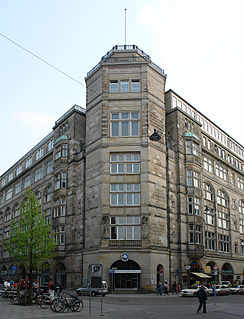
The Bremen Cotton Exchange was built in 1902 on the market square in Bremen, Germany, to house the offices of the city's cotton exchange founded in 1872. Johann Poppe's Neo-Renaissance facades and carefully finished interiors can still be seen today.

Śniadecki Street is one of the most important streets of downtown Bydgoszcz, with an important mercantile concentration.




















